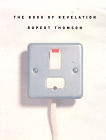
The Book Of Revelation
The Book Of Revelation Rupert Thompson Bloomsbury London 1999 264pp £12.99 0747544395
Merchandise Links
UK Edition: Amazon.co.uk |
What is surprising about this novel, as compared to Thomson’s others (Dreams Of Leaving, The Five Gates Of Hell, Air And Fire, The Insult, and Soft), is the looseness of the structure. I had expected both a denseness of imagery, and a fibrous construction–with each new image evoking a new narrative frame of mind which pushes the story onwards. In fact, Thomson still uses this technique, but on a larger scale. The story still weaves in and out of states of consciousness, but the weaving is blunter, more obvious. In this sense, then, The Book Of Revelation is a departure.
As in his other books, Thomson is concerned with stripping away layers. He always wants to know what happens when a really obvious facet of someone’s identity is removed. Is the identity still the same at bottom? In The Insult, for example, the protagonist loses his sight. In The Book of Revelation, meanwhile, the protagonist undergoes a peculiar depravation of will when he is made a sexual hostage. And so the nameless, beautiful dancer (in a world full of other people’s names) who sometimes refers to himself as ‘I,’ and sometimes as ‘He,’ undergoes an inverted transformation. The butterfly gets re-absorbed into the chrysalis. Thomson’s narrative filters through a sexually traumatised male consciousness, and this is, perhaps, the reason for the looser structure of the novel–the enormous gaps left in the protagonist’s identity as a man are manifest as large, abrupt narrative shifts. The namelessness is reinforced by the blunt shifts in consciousness, by the apparent gaps in the protagonist’s memory–and in his sense of self.
Is this looser structure successful? To be honest I don’t think this is Thomson’s magnum opus. I recognise that the identity issue at sake in The Book Of Revelation is in some ways more subtle than, say, the blindness of The Insult–but then surely it demands a subtle treatment? The dramatic shifts from ‘I’ to ‘He,’ while perhaps intended to signify the enormous rifts in the protagonist’s male identity and memory, feel heavy-handed to me, too much like arrows pointing towards trauma– ‘these blank spots are where he was hurt,’ they seem to say.
An underlying theme which is subtly and gracefully handled, however, is the issue of the relation of trauma to the artistic consciousness. At the novel’s start the protagonist is a dancer, but as he recovers from his nightmarish experience he stops dancing. Towards the end we see that he may become a choreographer. In fact, it is during his imprisonment that he choreographs his most creative piece:
‘From the first moment of his entrance, the music starting quietly, poignantly, the notes ascending in a minor key, he used the chain as a stand in for Odile. Whenever he was required to dance with her he danced with the chain instead, holding it, lifting it, parading it about. This had worked the day before, in rehearsal, and it worked even better now, especially in the slow waltz that formed part of the pas de deux.’
Here, under double confinement (he is imprisoned and chained–in fact it is specifically his penis to which the chain has been attached), the dancer is able to express more because of his obvious handicap. He is forced to use his constraints to express himself more clearly–and this confinement, Thomson seems to be saying, is the fundamental tool of art. Without it the drive to probe the deeper levels of consciousness does not exist. Finally, then, the true revelation in this book is not about sexual identity at all, but rather the artist’s fundamental experience of the movement of consciousness itself.
Reviewed by Amanda Jeremin Harris
